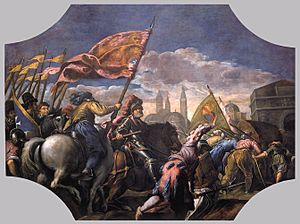Siege of Padua facts for kids
Quick facts for kids Siege of Padua |
|||||||
|---|---|---|---|---|---|---|---|
| Part of the War of the League of Cambrai | |||||||
 Padua reconquered by Andrea Gritti and Giovanni Diedo, painting by Palma il Giovane in the Doge's Palace of Venice |
|||||||
|
|||||||
| Belligerents | |||||||
| Commanders and leaders | |||||||
| Strength | |||||||
| 40,000 120–200 cannon |
15,000 | ||||||
| Casualties and losses | |||||||
| at least 300 killed, 400 wounded (in the assault in sector Codalunga) | |||||||
The Siege of Padua was an important battle that happened a long time ago. It was part of a bigger conflict called the War of the League of Cambrai. This war involved many powerful groups in Europe. The siege took place in September 1509 in the city of Padua, which is in modern-day Italy. It was a fight between the Republic of Venice and a large army led by Emperor Maximilian I.
Contents
What Was the Siege of Padua?
The Siege of Padua was a key event in the War of the League of Cambrai. This war was fought between 1508 and 1516. It involved many European powers, like France, the Holy Roman Empire, and the Papal States. They all wanted to control parts of Italy. The city of Padua was very important because of its location.
How Did the Siege Begin?
In June 1509, the Emperor's forces had taken control of Padua. But the Venetians wanted their city back. On July 17, a Venetian commander named Andrea Gritti led his soldiers from Treviso. They quickly recaptured Padua. The Emperor's soldiers, called landsknechts, had been guarding the city.
Emperor Maximilian I was not happy about losing Padua. He decided to gather a huge army to take it back. This army was made up of many hired soldiers, known as mercenaries. Maximilian planned to invade the Venetian region, called the Veneto.
The Battle for Padua's Walls
In early August 1509, Emperor Maximilian started his march. He left Trento with about 35,000 soldiers. They headed south into Venetian lands. Along the way, soldiers from France and the Papal States joined his army.
However, Maximilian's army had problems. They did not have enough horses. Their organization was also not very good. Because of these issues, they did not reach Padua until mid-September. This delay gave the Venetian commander, Niccolò di Pitigliano, time. He was able to gather the remaining Venetian soldiers. Many volunteers from Venice also came to help defend the city.
The actual siege began on September 15. For two weeks, the Emperor's and French armies fired their cannons at Padua. They managed to break through parts of the city walls. But when their soldiers tried to enter, the Venetians fought back hard. They stopped the attackers from getting inside.
One major attack happened in an area of the walls called Codalunga. About 7,500 Landsknechts tried to break through there. This part of the wall had been hit the most by cannons. But a mercenary commander named Citolo da Perugia defended it well. His team had set up hidden traps and mines. These mines exploded, killing 300 attackers and injuring 400 more.
Who Won the Siege?
By September 30, Emperor Maximilian faced another problem. He could not afford to pay his mercenaries anymore. Because of this, he had to stop the siege. He left a small group of soldiers in Italy. Then, he took the main part of his army back to Tyrol.
Losing the Siege of Padua was a big embarrassment for Emperor Maximilian. It showed that his army was not unbeatable. The Holy Roman Empire did not try to invade Italy again until 1516. This battle was a clear victory for the Republic of Venice.
See Also
 In Spanish: Sitio de Padua (1509) para niños
In Spanish: Sitio de Padua (1509) para niños

